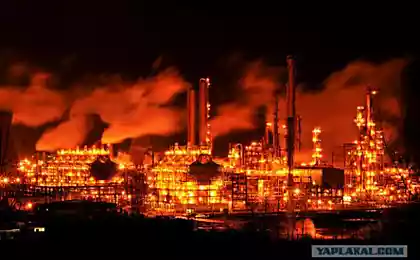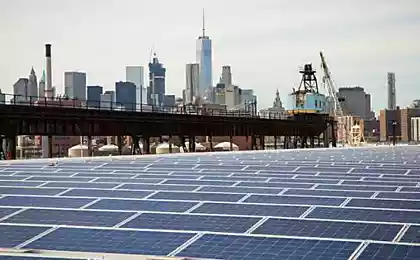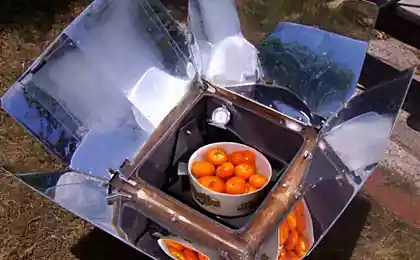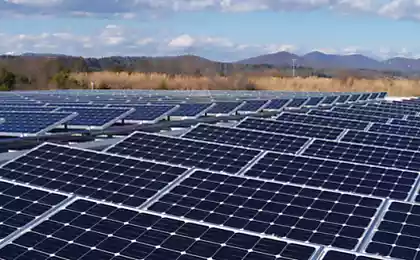544
Shams 1 - the world's largest solar energy plant
Abu Dhabi seeks to ensure that in 2020, the 7% government consumption of energy produced from renewable sources. Shams 1 — the world's largest plant of concentrated solar energy will help to achieve this goal. The plant, with a capacity of 100 MW, located 120 km South-West of the capital, uses parabolic trough technology to convert solar energy into electricity.
The mirror of the trough is tracking the sun all the way across the sky, focusing sunlight on tubes of synthetic oil that passes through the entire system. Thermal energy from the oil is ultimately transferred to the water converting it into steam, which in turn, drives a conventional steam turbine. At Shams 1 also has an extra heater that runs on gas fuel, which increases the steam temperature to 140 degrees Celsius, increasing the efficiency of the generators is about 20 %.

After approval of funding in the framework of the development of the United Nations (United Nations Clean Development Mechanism, CDM), the plant, owned by the companies Masdar, Abengoa and Total was launched at a time when photovoltaic technology was very expensive.
Avoiding annual emissions of 175 thousand tons of carbon dioxide, the plant Shams 1 will produce sufficient energy to provide 20 million homes. The plant consists of 258,048 parabolic mirrors and support structures, thus occupying an area of one square mile.
The place for the plant was chosen for several reasons, not the least of which is an appropriate infrastructure of power grids, which facilitates easy integration into the electricity system. The gas industry in the region, will also help to keep solar power in case of problems with submission, therefore, Shams 1 will always be able to give power of 100 MW.
Shams 1 should start the power supply to the national network in the first few months of this year.

Director Masdar's Clean Energy also fascinated by the idea of the technology of carbon Capture, Utilization and Storage of Carbon (Carbon Capture, Usage and Storage technology — CCUS), which is considered by many scientists as one of the most important and least understood tools to reduce the impact on climate change.
There are several ways to capture carbon, explains Al Lamki – prior and residual burning. However, the technology is still not economically feasible due to the cost. Current CCUS technology raise the price of fuel at 97%.

Source: /users/104
The mirror of the trough is tracking the sun all the way across the sky, focusing sunlight on tubes of synthetic oil that passes through the entire system. Thermal energy from the oil is ultimately transferred to the water converting it into steam, which in turn, drives a conventional steam turbine. At Shams 1 also has an extra heater that runs on gas fuel, which increases the steam temperature to 140 degrees Celsius, increasing the efficiency of the generators is about 20 %.

After approval of funding in the framework of the development of the United Nations (United Nations Clean Development Mechanism, CDM), the plant, owned by the companies Masdar, Abengoa and Total was launched at a time when photovoltaic technology was very expensive.
Avoiding annual emissions of 175 thousand tons of carbon dioxide, the plant Shams 1 will produce sufficient energy to provide 20 million homes. The plant consists of 258,048 parabolic mirrors and support structures, thus occupying an area of one square mile.
The place for the plant was chosen for several reasons, not the least of which is an appropriate infrastructure of power grids, which facilitates easy integration into the electricity system. The gas industry in the region, will also help to keep solar power in case of problems with submission, therefore, Shams 1 will always be able to give power of 100 MW.
Shams 1 should start the power supply to the national network in the first few months of this year.

Director Masdar's Clean Energy also fascinated by the idea of the technology of carbon Capture, Utilization and Storage of Carbon (Carbon Capture, Usage and Storage technology — CCUS), which is considered by many scientists as one of the most important and least understood tools to reduce the impact on climate change.
There are several ways to capture carbon, explains Al Lamki – prior and residual burning. However, the technology is still not economically feasible due to the cost. Current CCUS technology raise the price of fuel at 97%.

Source: /users/104























